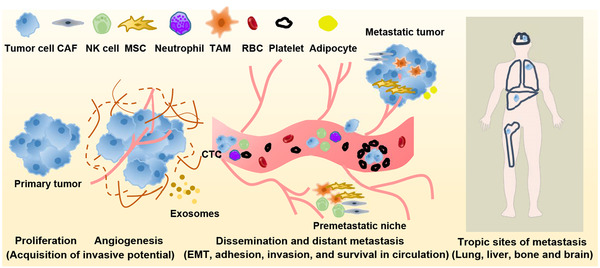FIGURE 1.

Overview of the metastatic cascade. Carcinoma cells escaping from the primary tumor migrate and invade through the basement membrane and extracellular matrix, enter the blood or lymphatic vessels, intravasate into the circulation, penetrate the blood or lymphatic vessels (extravasation), and adhere and grow in secondary sites. A variety of stromal cells, immune cells, and other molecular components surrounding the tumor provide signals that enhance the metastatic potential of cancer cells. Platelets and neutrophils can protect tumor cells by providing physical protection against shear stress, secreting mediators (such as transforming growth factor‐beta (TGF‐β)), neutralizing the cytotoxicity of NK cells and favoring immune escape. Abbreviations: BM, basement membrane; CAF, cancer‐associated fibroblast; CTC, circulating tumor cell; ECM, extracellular matrix; EMT, epithelial‐to‐mesenchymal transition; MSC, mesenchymal stem cell; NK cell, natural killer cell; RBC, red blood cell; TAM, tumor‐associated macrophage
